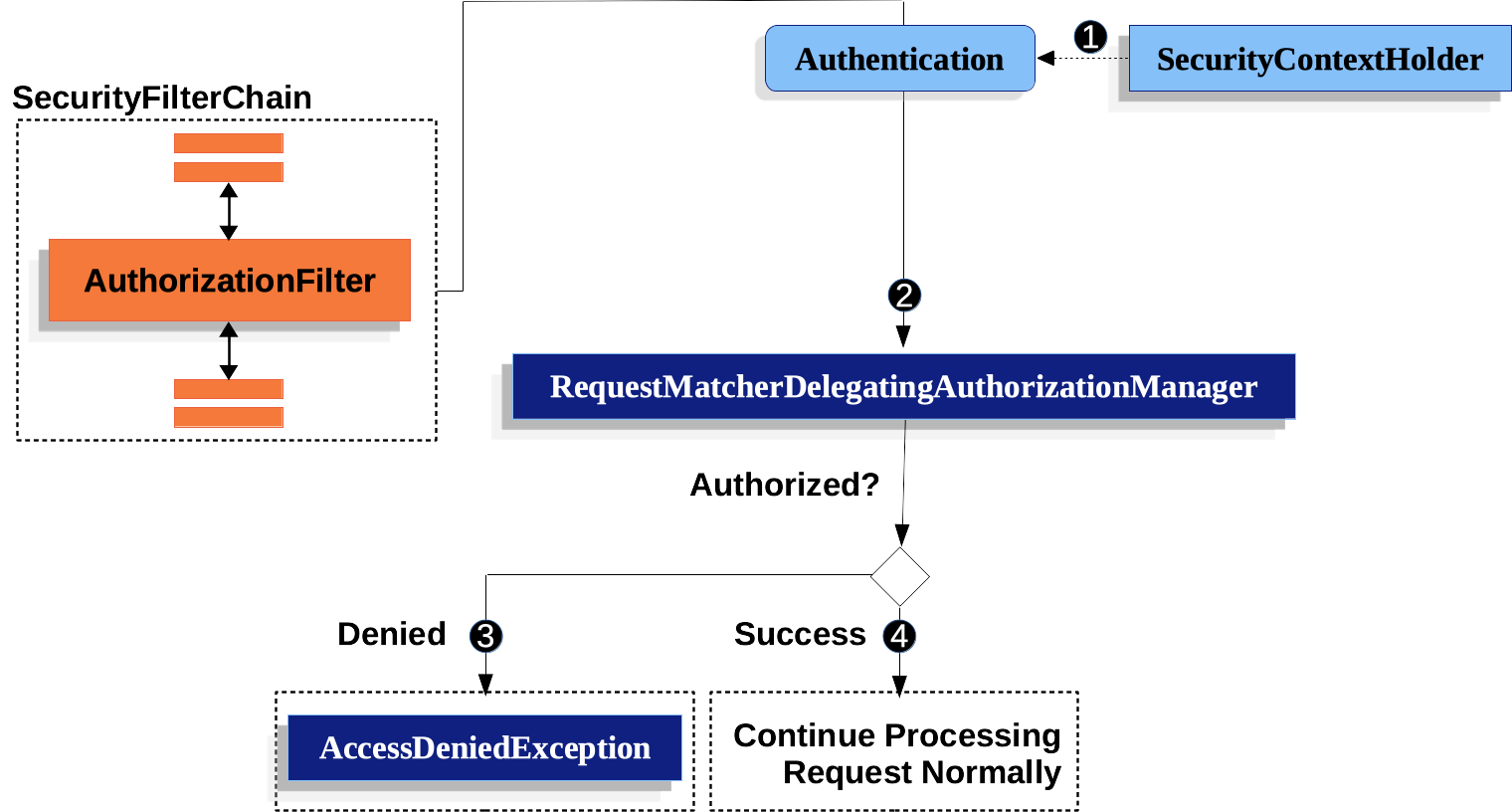|
对于最新的稳定版本,请使用 Spring Security 6.3.1! |
|
对于最新的稳定版本,请使用 Spring Security 6.3.1! |
本节以 Servlet 体系结构和实现为基础,深入探讨授权在基于 Servlet 的应用程序中的工作方式。
AuthorizationFilter取代 FilterSecurityInterceptor。
要保持向后兼容,则仍然是默认值。
本节讨论工作原理以及如何覆盖默认配置。FilterSecurityInterceptorAuthorizationFilter |
AuthorizationFilter 为 s 提供授权。
它作为安全过滤器之一插入到 FilterChainProxy 中。HttpServletRequest
您可以在声明 .
不要使用 authorizeRequests,而是使用 ,如下所示:SecurityFilterChainauthorizeHttpRequests
-
Java
@Bean
SecurityFilterChain web(HttpSecurity http) throws AuthenticationException {
http
.authorizeHttpRequests((authorize) -> authorize
.anyRequest().authenticated();
)
// ...
return http.build();
}这在许多方面得到了改进:authorizeRequests
-
使用简化的 API,而不是元数据源、配置属性、决策管理器和投票者。 这简化了重用和自定义。
AuthorizationManager -
延迟查找。 它不需要为每个请求查找身份验证,而只会在授权决策需要身份验证的请求中查找身份验证。
Authentication -
基于 Bean 的配置支持。
当使用 而不是 时,则使用 AuthorizationFilter 而不是 FilterSecurityInterceptor。authorizeHttpRequestsauthorizeRequests

-
 首先,从 SecurityContextHolder 获取身份验证。
它将其包装在一个中,以便延迟查找。
首先,从 SecurityContextHolder 获取身份验证。
它将其包装在一个中,以便延迟查找。AuthorizationFilterSupplier -
 其次,它将 和 传递给
其次,它将 和 传递给 AuthorizationManager。Supplier<Authentication>HttpServletRequest-
 如果授权被拒绝,则抛出 an。
在本例中,
如果授权被拒绝,则抛出 an。
在本例中,ExceptionTranslationFilter处理 .AccessDeniedExceptionAccessDeniedException -
 如果授予访问权限,则继续使用 FilterChain,允许应用程序正常处理。
如果授予访问权限,则继续使用 FilterChain,允许应用程序正常处理。AuthorizationFilter
-
我们可以通过按优先级顺序添加更多规则来配置 Spring Security 以具有不同的规则。
-
Java
@Bean
SecurityFilterChain web(HttpSecurity http) throws Exception {
http
// ...
.authorizeHttpRequests(authorize -> authorize (1)
.requestMatchers("/resources/**", "/signup", "/about").permitAll() (2)
.requestMatchers("/admin/**").hasRole("ADMIN") (3)
.requestMatchers("/db/**").access(new WebExpressionAuthorizationManager("hasRole('ADMIN') and hasRole('DBA')")) (4)
// .requestMatchers("/db/**").access(AuthorizationManagers.allOf(AuthorityAuthorizationManager.hasRole("ADMIN"), AuthorityAuthorizationManager.hasRole("DBA"))) (5)
.anyRequest().denyAll() (6)
);
return http.build();
}| 1 | 指定了多个授权规则。 每条规则都按其声明的顺序进行考虑。 |
| 2 | 我们指定了任何用户都可以访问的多个 URL 模式。 具体而言,如果 URL 以“/resources/”开头、等于“/signup”或等于“/about”,则任何用户都可以访问请求。 |
| 3 | 任何以“/admin/”开头的 URL 都将仅限于角色为“ROLE_ADMIN”的用户。
您会注意到,由于我们正在调用该方法,因此我们不需要指定“ROLE_”前缀。hasRole |
| 4 | 任何以“/db/”开头的 URL 都要求用户同时具有“ROLE_ADMIN”和“ROLE_DBA”。
您会注意到,由于我们使用的是表达式,因此我们不需要指定“ROLE_”前缀。hasRole |
| 5 | 来自 4 的相同规则,可以通过组合多个 .AuthorizationManager |
| 6 | 任何尚未匹配的 URL 都将被拒绝访问。 如果您不想意外忘记更新授权规则,这是一个很好的策略。 |
您可以通过构造自己的 RequestMatcherDelegatingAuthorizationManager 来采用基于 Bean 的方法,如下所示:
-
Java
@Bean
SecurityFilterChain web(HttpSecurity http, AuthorizationManager<RequestAuthorizationContext> access)
throws AuthenticationException {
http
.authorizeHttpRequests((authorize) -> authorize
.anyRequest().access(access)
)
// ...
return http.build();
}
@Bean
AuthorizationManager<RequestAuthorizationContext> requestMatcherAuthorizationManager(HandlerMappingIntrospector introspector) {
MvcRequestMatcher.Builder mvcMatcherBuilder = new MvcRequestMatcher.Builder(introspector);
RequestMatcher permitAll =
new AndRequestMatcher(
mvcMatcherBuilder.pattern("/resources/**"),
mvcMatcherBuilder.pattern("/signup"),
mvcMatcherBuilder.pattern("/about"));
RequestMatcher admin = mvcMatcherBuilder.pattern("/admin/**");
RequestMatcher db = mvcMatcherBuilder.pattern("/db/**");
RequestMatcher any = AnyRequestMatcher.INSTANCE;
AuthorizationManager<HttpServletRequest> manager = RequestMatcherDelegatingAuthorizationManager.builder()
.add(permitAll, (context) -> new AuthorizationDecision(true))
.add(admin, AuthorityAuthorizationManager.hasRole("ADMIN"))
.add(db, AuthorityAuthorizationManager.hasRole("DBA"))
.add(any, new AuthenticatedAuthorizationManager())
.build();
return (context) -> manager.check(context.getRequest());
}您还可以为任何请求匹配器连接自己的自定义授权管理器。
-
Java
@Bean
SecurityFilterChain web(HttpSecurity http) throws Exception {
http
.authorizeHttpRequests((authorize) -> authorize
.requestMatchers("/my/authorized/endpoint").access(new CustomAuthorizationManager());
)
// ...
return http.build();
}或者,您可以为所有请求提供它,如下所示:
-
Java
@Bean
SecurityFilterChain web(HttpSecurity http) throws Exception {
http
.authorizeHttpRequests((authorize) -> authorize
.anyRequest().access(new CustomAuthorizationManager());
)
// ...
return http.build();
}默认情况下,不适用于 和 。
我们可以使用以下方法将 Spring Security 配置为将授权规则应用于所有调度程序类型:AuthorizationFilterDispatcherType.ERRORDispatcherType.ASYNCshouldFilterAllDispatcherTypes
-
Java
-
Kotlin
@Bean
SecurityFilterChain web(HttpSecurity http) throws Exception {
http
.authorizeHttpRequests((authorize) -> authorize
.shouldFilterAllDispatcherTypes(true)
.anyRequest.authenticated()
)
// ...
return http.build();
}@Bean
open fun web(http: HttpSecurity): SecurityFilterChain {
http {
authorizeHttpRequests {
shouldFilterAllDispatcherTypes = true
authorize(anyRequest, authenticated)
}
}
return http.build()
}现在,将授权规则应用于所有调度程序类型后,您可以更好地控制对它们的授权。
例如,您可能希望配置为对具有调度程序类型或 .shouldFilterAllDispatcherTypestrueASYNCFORWARD
-
Java
-
Kotlin
@Bean
SecurityFilterChain web(HttpSecurity http) throws Exception {
http
.authorizeHttpRequests((authorize) -> authorize
.shouldFilterAllDispatcherTypes(true)
.dispatcherTypeMatchers(DispatcherType.ASYNC, DispatcherType.FORWARD).permitAll()
.anyRequest().authenticated()
)
// ...
return http.build();
}@Bean
open fun web(http: HttpSecurity): SecurityFilterChain {
http {
authorizeHttpRequests {
shouldFilterAllDispatcherTypes = true
authorize(DispatcherTypeRequestMatcher(DispatcherType.ASYNC, DispatcherType.FORWARD), permitAll)
authorize(anyRequest, authenticated)
}
}
return http.build()
}您还可以自定义它以要求调度程序类型的特定角色:
-
Java
-
Kotlin
@Bean
SecurityFilterChain web(HttpSecurity http) throws Exception {
http
.authorizeHttpRequests((authorize) -> authorize
.shouldFilterAllDispatcherTypes(true)
.dispatcherTypeMatchers(DispatcherType.ERROR).hasRole("ADMIN")
.anyRequest().authenticated()
)
// ...
return http.build();
}@Bean
open fun web(http: HttpSecurity): SecurityFilterChain {
http {
authorizeHttpRequests {
shouldFilterAllDispatcherTypes = true
authorize(DispatcherTypeRequestMatcher(DispatcherType.ERROR), hasRole("ADMIN"))
authorize(anyRequest, authenticated)
}
}
return http.build()
}
AuthorizationFilter取代 FilterSecurityInterceptor。
要保持向后兼容,则仍然是默认值。
本节讨论工作原理以及如何覆盖默认配置。FilterSecurityInterceptorAuthorizationFilter |
| 1 | 指定了多个授权规则。 每条规则都按其声明的顺序进行考虑。 |
| 2 | 我们指定了任何用户都可以访问的多个 URL 模式。 具体而言,如果 URL 以“/resources/”开头、等于“/signup”或等于“/about”,则任何用户都可以访问请求。 |
| 3 | 任何以“/admin/”开头的 URL 都将仅限于角色为“ROLE_ADMIN”的用户。
您会注意到,由于我们正在调用该方法,因此我们不需要指定“ROLE_”前缀。hasRole |
| 4 | 任何以“/db/”开头的 URL 都要求用户同时具有“ROLE_ADMIN”和“ROLE_DBA”。
您会注意到,由于我们使用的是表达式,因此我们不需要指定“ROLE_”前缀。hasRole |
| 5 | 来自 4 的相同规则,可以通过组合多个 .AuthorizationManager |
| 6 | 任何尚未匹配的 URL 都将被拒绝访问。 如果您不想意外忘记更新授权规则,这是一个很好的策略。 |
请求匹配器
该接口用于确定请求是否与给定规则匹配。
我们用来确定是否应该将给定的请求应用于给定的请求。
同样,我们可以用来确定应应用于给定请求的授权规则。
请看以下示例:RequestMatchersecurityMatchersHttpSecurityrequestMatchers
-
Java
-
Kotlin
@Configuration
@EnableWebSecurity
public class SecurityConfig {
@Bean
public SecurityFilterChain securityFilterChain(HttpSecurity http) throws Exception {
http
.securityMatcher("/api/**") (1)
.authorizeHttpRequests(authorize -> authorize
.requestMatchers("/user/**").hasRole("USER") (2)
.requestMatchers("/admin/**").hasRole("ADMIN") (3)
.anyRequest().authenticated() (4)
)
.formLogin(withDefaults());
return http.build();
}
}@Configuration
@EnableWebSecurity
open class SecurityConfig {
@Bean
open fun web(http: HttpSecurity): SecurityFilterChain {
http {
securityMatcher("/api/**") (1)
authorizeHttpRequests {
authorize("/user/**", hasRole("USER")) (2)
authorize("/admin/**", hasRole("ADMIN")) (3)
authorize(anyRequest, authenticated) (4)
}
}
return http.build()
}
}| 1 | 配置为仅应用于以HttpSecurity/api/ |
| 2 | 允许访问以具有该角色的用户开头的 URL/user/USER |
| 3 | 允许访问以具有该角色的用户开头的 URL/admin/ADMIN |
| 4 | 任何其他与上述规则不匹配的请求都需要身份验证 |
和 方法将决定哪种实现最适合您的应用程序:如果 Spring MVC 在类路径中,则将使用 then,否则将使用。
您可以在此处阅读有关 Spring MVC 集成的更多信息。securityMatcher(s)requestMatcher(s)RequestMatcherMvcRequestMatcherAntPathRequestMatcher
如果要使用特定的 ,只需将实现传递给 and/or 方法:RequestMatchersecurityMatcherrequestMatcher
-
Java
-
Kotlin
import static org.springframework.security.web.util.matcher.AntPathRequestMatcher.antMatcher; (1)
import static org.springframework.security.web.util.matcher.RegexRequestMatcher.regexMatcher;
@Configuration
@EnableWebSecurity
public class SecurityConfig {
@Bean
public SecurityFilterChain securityFilterChain(HttpSecurity http) throws Exception {
http
.securityMatcher(antMatcher("/api/**")) (2)
.authorizeHttpRequests(authorize -> authorize
.requestMatchers(antMatcher("/user/**")).hasRole("USER") (3)
.requestMatchers(regexMatcher("/admin/.*")).hasRole("ADMIN") (4)
.requestMatchers(new MyCustomRequestMatcher()).hasRole("SUPERVISOR") (5)
.anyRequest().authenticated()
)
.formLogin(withDefaults());
return http.build();
}
}
public class MyCustomRequestMatcher implements RequestMatcher {
@Override
public boolean matches(HttpServletRequest request) {
// ...
}
}import org.springframework.security.web.util.matcher.AntPathRequestMatcher.antMatcher (1)
import org.springframework.security.web.util.matcher.RegexRequestMatcher.regexMatcher
@Configuration
@EnableWebSecurity
open class SecurityConfig {
@Bean
open fun web(http: HttpSecurity): SecurityFilterChain {
http {
securityMatcher(antMatcher("/api/**")) (2)
authorizeHttpRequests {
authorize(antMatcher("/user/**"), hasRole("USER")) (3)
authorize(regexMatcher("/admin/**"), hasRole("ADMIN")) (4)
authorize(MyCustomRequestMatcher(), hasRole("SUPERVISOR")) (5)
authorize(anyRequest, authenticated)
}
}
return http.build()
}
}| 1 | 从实例导入静态工厂方法,并创建实例。AntPathRequestMatcherRegexRequestMatcherRequestMatcher |
| 2 | 配置为仅应用于以 开头的 URL,使用HttpSecurity/api/AntPathRequestMatcher |
| 3 | 允许访问以具有角色的用户开头的 URL,使用/user/USERAntPathRequestMatcher |
| 4 | 允许访问以具有角色的用户开头的 URL,使用/admin/ADMINRegexRequestMatcher |
| 5 | 允许访问与具有角色的用户匹配的 URL,使用自定义MyCustomRequestMatcherSUPERVISORRequestMatcher |
| 1 | 配置为仅应用于以HttpSecurity/api/ |
| 2 | 允许访问以具有该角色的用户开头的 URL/user/USER |
| 3 | 允许访问以具有该角色的用户开头的 URL/admin/ADMIN |
| 4 | 任何其他与上述规则不匹配的请求都需要身份验证 |
| 1 | 从实例导入静态工厂方法,并创建实例。AntPathRequestMatcherRegexRequestMatcherRequestMatcher |
| 2 | 配置为仅应用于以 开头的 URL,使用HttpSecurity/api/AntPathRequestMatcher |
| 3 | 允许访问以具有角色的用户开头的 URL,使用/user/USERAntPathRequestMatcher |
| 4 | 允许访问以具有角色的用户开头的 URL,使用/admin/ADMINRegexRequestMatcher |
| 5 | 允许访问与具有角色的用户匹配的 URL,使用自定义MyCustomRequestMatcherSUPERVISORRequestMatcher |
表达 式
建议您使用类型安全授权管理器而不是 SpEL。
但是,可用于帮助迁移旧版 SpEL。WebExpressionAuthorizationManager
要使用 ,您可以使用您尝试迁移的表达式构造一个,如下所示:WebExpressionAuthorizationManager
-
Java
-
Kotlin
.requestMatchers("/test/**").access(new WebExpressionAuthorizationManager("hasRole('ADMIN') && hasRole('USER')")).requestMatchers("/test/**").access(WebExpressionAuthorizationManager("hasRole('ADMIN') && hasRole('USER')"))如果您在表达式中引用 bean,如下所示: ,建议您直接调用该 bean,如下所示:@webSecurity.check(authentication, request)
-
Java
-
Kotlin
.requestMatchers("/test/**").access((authentication, context) ->
new AuthorizationDecision(webSecurity.check(authentication.get(), context.getRequest()))).requestMatchers("/test/**").access((authentication, context): AuthorizationManager<RequestAuthorizationContext> ->
AuthorizationDecision(webSecurity.check(authentication.get(), context.getRequest())))对于包含 Bean 引用以及其他表达式的复杂指令,建议您更改这些指令以实现并通过调用 来引用它们。AuthorizationManager.access(AuthorizationManager)
如果无法执行此操作,则可以使用 Bean 解析器配置 a 并将其提供给 .DefaultHttpSecurityExpressionHandlerWebExpressionAuthorizationManager#setExpressionhandler